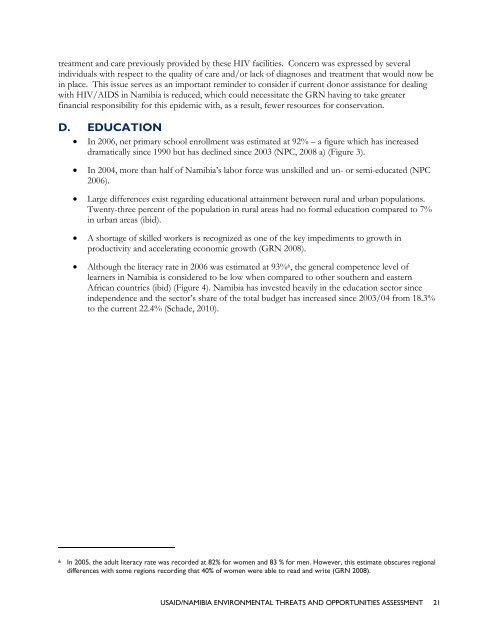usaid/nambia environmental threats and opportunities assessment
usaid/nambia environmental threats and opportunities assessment
usaid/nambia environmental threats and opportunities assessment
You also want an ePaper? Increase the reach of your titles
YUMPU automatically turns print PDFs into web optimized ePapers that Google loves.
treatment <strong>and</strong> care previously provided by these HIV facilities. Concern was expressed by several<br />
individuals with respect to the quality of care <strong>and</strong>/or lack of diagnoses <strong>and</strong> treatment that would now be<br />
in place. This issue serves as an important reminder to consider if current donor assistance for dealing<br />
with HIV/AIDS in Namibia is reduced, which could necessitate the GRN having to take greater<br />
financial responsibility for this epidemic with, as a result, fewer resources for conservation.<br />
D. EDUCATION<br />
<br />
In 2006, net primary school enrollment was estimated at 92% – a figure which has increased<br />
dramatically since 1990 but has declined since 2003 (NPC, 2008 a) (Figure 3).<br />
<br />
<br />
<br />
<br />
In 2004, more than half of Namibia’s labor force was unskilled <strong>and</strong> un- or semi-educated (NPC<br />
2006).<br />
Large differences exist regarding educational attainment between rural <strong>and</strong> urban populations.<br />
Twenty-three percent of the population in rural areas had no formal education compared to 7%<br />
in urban areas (ibid).<br />
A shortage of skilled workers is recognized as one of the key impediments to growth in<br />
productivity <strong>and</strong> accelerating economic growth (GRN 2008).<br />
Although the literacy rate in 2006 was estimated at 93% 6 , the general competence level of<br />
learners in Namibia is considered to be low when compared to other southern <strong>and</strong> eastern<br />
African countries (ibid) (Figure 4). Namibia has invested heavily in the education sector since<br />
independence <strong>and</strong> the sector’s share of the total budget has increased since 2003/04 from 18.3%<br />
to the current 22.4% (Schade, 2010).<br />
6 In 2005, the adult literacy rate was recorded at 82% for women <strong>and</strong> 83 % for men. However, this estimate obscures regional<br />
differences with some regions recording that 40% of women were able to read <strong>and</strong> write (GRN 2008).<br />
USAID/NAMIBIA ENVIRONMENTAL THREATS AND OPPORTUNITIES ASSESSMENT 21

















